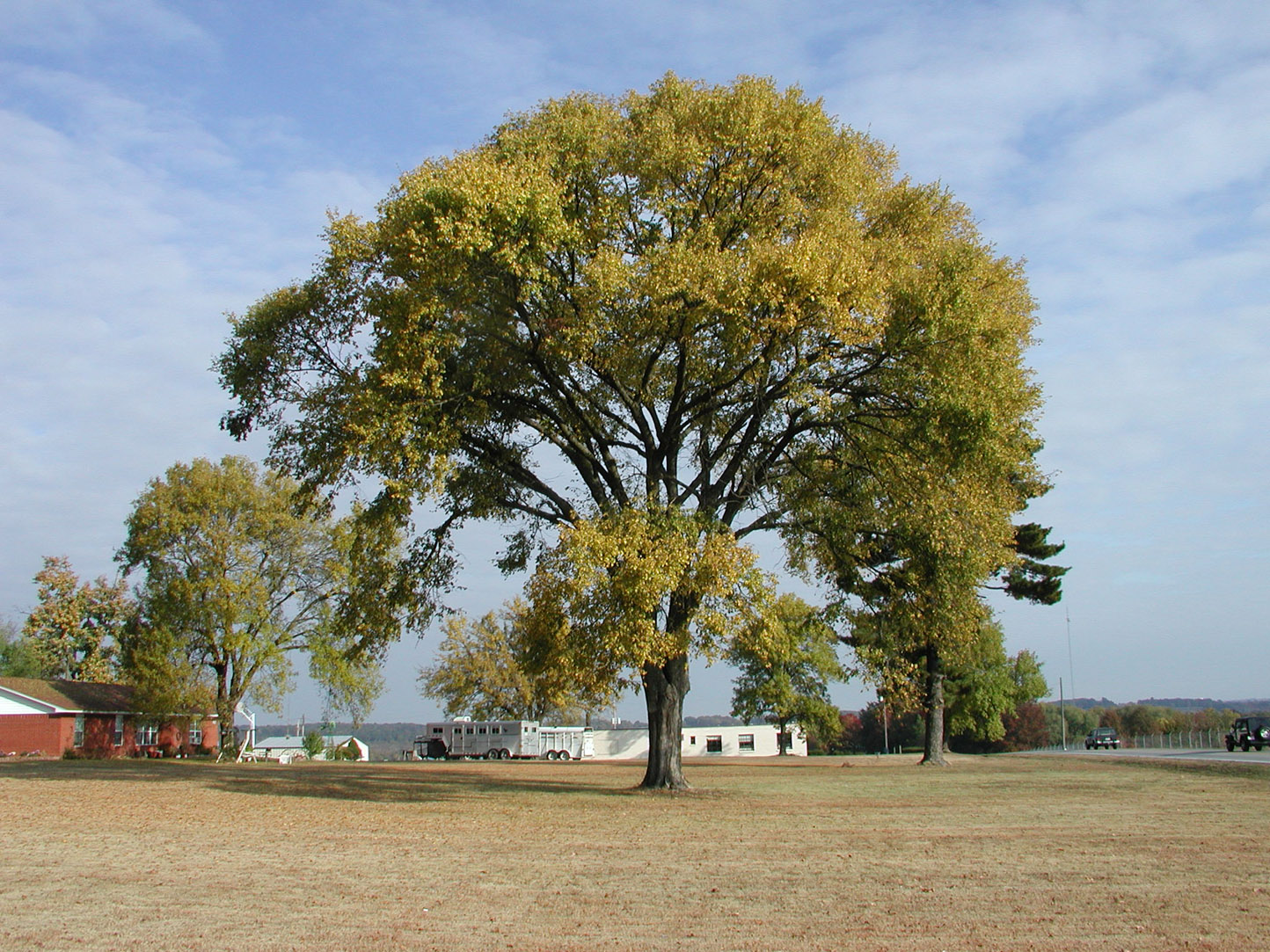Resource Library
Plant of the Week: Ulmus americana American Elm Princeton Elm wk 42 2015
Ulmus americana American Elm Princeton Elm wk 42 2015 — American elm is one of our most stately native trees. Though it is susceptible to disease some resistant selections make using this big tree a safe bet in landscape plantings. (Image courtesy Gerald Klingaman)
Download High Resolution
Elms have been dying in increased numbers across Arkansas the last couple years, probably because of the added stress of the 2011 and 2012 droughts. Dutch elm disease is the main cause of elm tree death, and it seems to be worse some years — especially when environmental stress gives it a nudge. American elm is perhaps our most stately native tree and it used to be the most common large shade tree across the eastern half of the United States. It is no wimp of a tree, growing to 100 feet tall and wide, with a crown profile that is almost umbrella shaped.
But in 1930, a shipment of elm logs from England brought in a fungus disease that was unknown to our elms and to which they had no resistance. The disease marched across the US, leaving dead stubs in its wake as the elm canopy of many cities died. It reached Arkansas in the 1960s. Dutch elm disease (DED) is a non-discriminatory assassin, killing young trees and old trees with equal frequency. DED kills several of our native elm species, but does not spread to other kinds of trees. It kills about 95 percent of the elms in an area when it first strikes, and kills the remaining elms over the next few decades.
The disease is spread by elm bark beetles. Once DED gains a foothold in the tree, it spreads throughout the vascular system of the tree, creating terminal hardening of the arteries. Usually the first symptom of the disease is leaves on a limb in the top of a tree yellowing and then turning brown. This commonly happens early in the summer so the leaves stay on the branch and don’t fall off. The following year a larger section of the tree will die and in most cases the tree will be dead within 2 to 3 years of initial infection.
Heroic effort has been made to control the disease, but Mother Nature tends to have her own way in such matters. The first widespread control efforts revolved around the control of the elm bark beetles. Extensive spray programs were launched in the 1950s using dichlorodiphenyltrichloroethane, the pesticide commonly known as DDT. This turned out to be a lot more detrimental to the song bird population than it did to the beetles. Spray efforts were dropped in the late 1960s in favor of intravenous injection of fungicides to control the fungus. This didn’t work either, but at least it had no effect on the bird population.
Tree breeders began trying to develop resistant elm trees in the 1960s using European elms with built-in resistance. The first release, ‘Urban’ Elm, came along about 1980 but never really took off in the nursery trade because it lacked the stature and form of the American elm. Many other hybrid elms have appeared including “Accolade,” ”Homestead” and “Pioneer,” but none have the chops to replace our native species.
Over the past four decades the disease resistance picture has become clearer for our native species. Some mature American elms had a high degree of natural resistance and survived the initial onslaught of the disease. Today it appears that “Delaware No. 2” out of Ohio, “Jefferson” off of the National Mall in Washington, DC, “Liberty,” a Wisconsin release, and Ohio’s “New Harmony” and Pennsylvania’s “Valley Forge,” both released by the U.S. National Arboretum, are among the most resistant selections.
“Princeton” is a 1922 introduction by a New Jersey nursery that is probably the most common American elm we see in the nursery trade today. It was released before DED arrived on our shores and has good, but not perfect, DED resistance. The trees grow fast, have heavy waxy foliage and show the classic American elm form. These resistant clones provide a way to reestablish the American elm in our parks and large landscape properties across the country. But, to ensure we never have this kind of calamity again in the future, the urban forest canopy of our cities should be diverse and comprised of many species, not just a few.
As a shade tree, the American elm is wonderful. But as a part of the modern landscape it is less than ideal. For one thing, it is too big for many of our smaller landscapes. It also has a ravenous appetite for water and fertilizer and will out-compete anything planted within the radius of its far-ranging roots. We will probably never see the widespread return of elms to our landscapes, but I for one hope that they never disappear completely. The American elm is a part of our American heritage that is worth preserving.
For more information about horticulture or to see other Plant of the Week columns, visit Extension's Web site, www.uaex.uada.edu, or contact your county extension agent. The Cooperative Extension Service is part of the U of A Division of Agriculture.
Pursuant to 7 CFR § 15.3, the University of Arkansas System Division of Agriculture offers all its Extension and Research programs and services (including employment) without regard to race, color, sex, national origin, religion, age, disability, marital or veteran status, genetic information, sexual preference, pregnancy or any other legally protected status, and is an equal opportunity institution.
